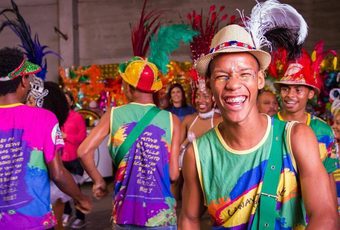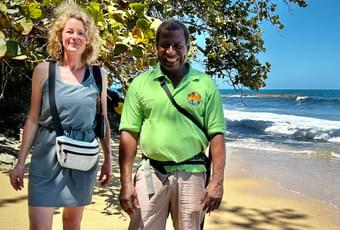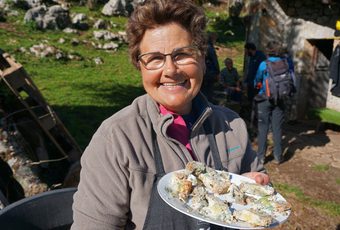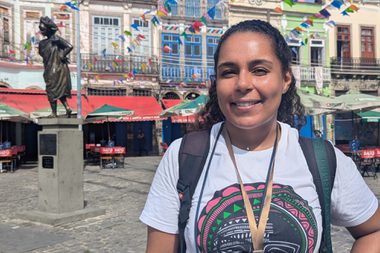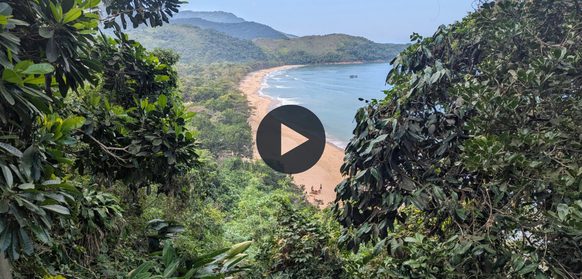Seven tasty treats you MUST try whilst travelling in Rio
Brazil's cuisine is wonderfully diverse, as befits the fifth-largest country in the world. The Amazon is a larder of exotic fruits. Bahian cuisine is a colourful fusion of traditionally African and indigenous ingredients. Minas Gerais is the powerhouse of Brazil's rural staples; rice, beans, beef, cheese and bread.
On any trip here, food will be an absolute highlight. You will eat a lot of variations of Brazil's most famous dish - black bean stew. One evening might be spent dining tapas style in the 'boteco' bars of Rio. Grilled fish with your toes in the sand is the thing to do on the beach. You will eat more exotic fruits than you can remember the names of. And then there's the artisan cheese and brigadero sweets.

In the name of journalistic research, we've tried and tested it all for you. After a good lie down, we picked our favourite seven...
1. Mate Leão & Globo
Let's start on the famous sands of Ipanema and Copacabana.
Forget coconuts and a straw. Nothing says beach day like a cold glug of Maté Leão and a bag of crunchy Globo biscuits — the classic Carioca combo.
Maté Leão is a brand of iced tea, made from the yerba maté tree, common in the subtropical parts of South America. If you've ever been to Patagonia, you'll know maté as a hot drink. But in the tropical climes of Rio, that was never going to do, and so in the 1950s, locals began to drink it iced on the beach and during football matches at the Maracanã. The idea took hold and now it's an institution.



Orange-shirted vendors sell the drink 'on tap' up and down Ipanema and Copacabana, and you can even add in a splash of Brazilian rum if you're feeling a bit naughty.
Its fame reached beyond Brazilian shores when minor celeb Jeff Brazier and his son Freddy took to flogging it in the traditional get-up on Copacabana as part of the BBC's wildly popular Race Across the World programme. Poor Freddy lasted five minutes before he complained about being an aching shoulder. No stamina these young-uns.
2. Boteco tapas
In Rio, a boteco (or botequim) is a small, usually family-run bar where people stop in for a cold beer, a plate of Brazilian tapas (petiscos) and a catch-up with friends. The food isn’t fancy, but it’s tasty, generous and built for sharing. Each has its personality, from the corner spot with plastic chairs spilling onto the pavement to the old-school bar with wood panelling and walls lined with football memorabilia.
Santa Teresa is a real hotspot for botecos, and one of the reasons why we love to have you stay up in Rio's old cobbled heart.

Every year, these bars take part in Comida di Buteco (written phonetically), a nationwide competition that puts them centre stage. It began in Belo Horizonte in 1999 and has since spread across Brazil, including Rio. For about a month - usually from mid-April to mid-May - each participating bar creates a special snack for the contest. Customers try it out and score not only the food, but also the service, atmosphere and even down to the temperature of the drinks. The public’s vote carries real weight alongside the judges’.
What makes the competition stand out is that it’s not about big names or polished restaurants. Only independent, no-frills botecos are allowed to take part, so the event helps highlight places that might otherwise fly under the radar. It has become so important that, in 2024, Comida di Buteco was recognised as part of Rio’s cultural and gastronomic heritage.
3. Feijoada
Black-bean stews are a staple of the countryside, one of the central tenets of Old Brazil. It is served with beef, rice, sauteed vegetables or a salad, as well as the obligatory toasted cassava flour (farofa). In some cases, the dish is elevated from mere 'stew' status to a more elaborate feijoada by the addition of 'fancy' pork cuts, and perhaps a slice of orange to aid digestion.
Like many traditional dishes, it developed as a cheap, hearty meal for rural workers and farm communities, using locally available beans and preserved meats. For smallholders living the roça culture, which still prevails in the countryside outside of Rio, all of the ingredients could be sourced from their own farms, by their own means.

Countless restaurants serve it up in Rio, notably the Casa do Feijoada, a block inland from Ipanema. But for the true Old Brazil experience, you have to eat it slow-cooked as a communal al fresco lunch high in the hills outside the city, the smell of woodsmoke and coffee in the air, the sound of birdsong all around.
Nudge, nudge: Rio & Beyond: Brazil's Hidden Highlights
4. Cachaça
Cachaça is Brazil's national spirit. Simplicity in itself, it is made from by harvesting and juicing sugarcane, then distilling, fermenting and ageing the juice.
Unaged 'white' or 'silver' cachaça is the cheap stuff, typically bottled immediately or after a very short rest in stainless steel or neutral containers. Most of this ends up in caipirinhas, the famous cocktail that you will almost certainly try on your travels. Aged - 'gold' or 'amber' - cachaça is left to age in wooden barrels, most commonly 1 to 3 years, though some artisanal producers age it 5, 10 years, or longer. This is the good stuff and is savoured neat like a prized bourbon or whisky.
Or, as Ronaldo from the distillery put it so eloquently: "When you drink cachaça, swill it around in your mouth for a few seconds. If it burns, spit it out - it's rubbish. If it's smooth, you've got a good one."


Whilst there are some cachaça distilleries you can visit near Paraty, the best of the best is out in the countryside, very close to the coffee farm which takes centre stage in number six below. Visits are wonderfully informal. You follow the process from harvesting in the fields to juicing and distillation, ending with a guided tasting.
5. Açaí
We're importing number five from the Amazon, principally because açaí is wildly popular all over the country.
Açaí (pronounced a-ssa-ee) is both a palm tree and its deep purple fruit, native to northern Brazil near the Amazon. In Rio, it’s sold everywhere. Pure açaí tastes earthy, but the common version—blended with guaraná and banana syrup—becomes a creamy, icy, sweet energy boost.
So popular has it become that it is in fact now illegal to cut down the palm tree to get the fruits without proper permission - they take an age to grow back and reach maturity. Whilst hiking in the Mata Atlantica rainforest near Rio, you will likely see its southern cousin - juçara - growing wild. It produces a dark purple fruit similar to açaí, and the fruit pulp is also used in drinks and desserts.

6. Coffee risotto
I know, I know. Sounds odd. But hear me out...
Rio de Janeiro state has a rich tradition of coffee production. In its heyday, it once accounted for 90% of the production of the entire country. Now, coffee production is small-scale and artisan and if you're on our Rio & Beyond journey, you'll be staying at a wonderful coffee farm out in the countryside. But we can't get away with telling you to drink coffee in Brazil - that one rather takes care of itself.
So you're going to eat it instead.

Coffee risotto is made in much the same way you'd make any risotto. Except the key ingredient is a strong glug of premium coffee, mixed in with creamy mozzarella cheese from the farm's own herd of buffalo and served with a couple of chunks of meat from a less fortunate member of the same herd.
The result is delicious. Unless you really don't like coffee, in which case we're perhaps fighting a losing battle. But keep an open mind and perhaps skip the post-dinner espresso unless you want to stay up all night...
7. Moqueca
Let's finish with a taste of Bahia, another guest appearance from up north.
A moqueca originates from the Bahia region in northeast Brazil. It is a vibrant fish or seafood stew, slow-cooked in coconut milk, dendê, garlic, palm oil, tomatoes, onions, and peppers. Bursting with colour and flavour, it’s a coastal classic best enjoyed with rice and farofa.

If you're going up to Salvador, hold off and try it up there of course. Otherwise, there's a place in Urca that does a good turn in these, right next to the Sugar Loaf cable cars station. We tried Axé - a shrimp dish with a creamy cassava sauce - and loved it. Try to grab a table by the window overlooking the sea and Sugar Loaf.
